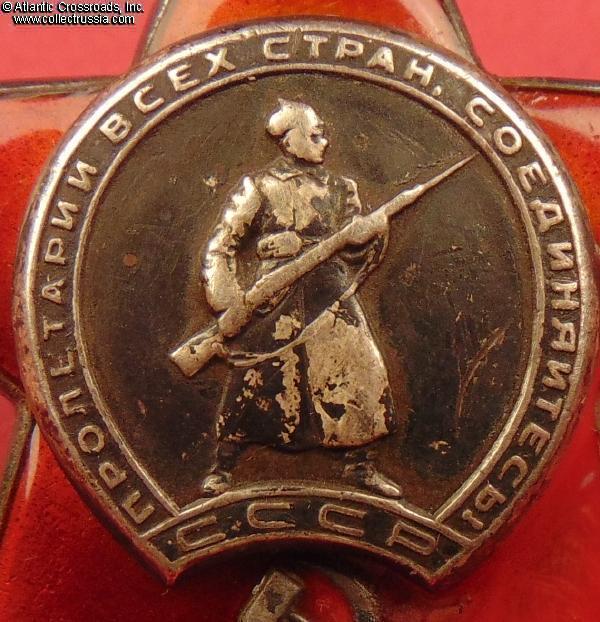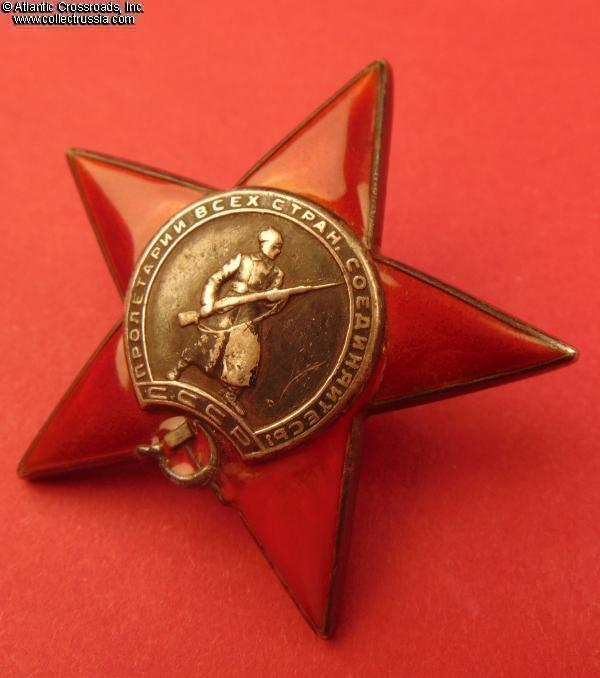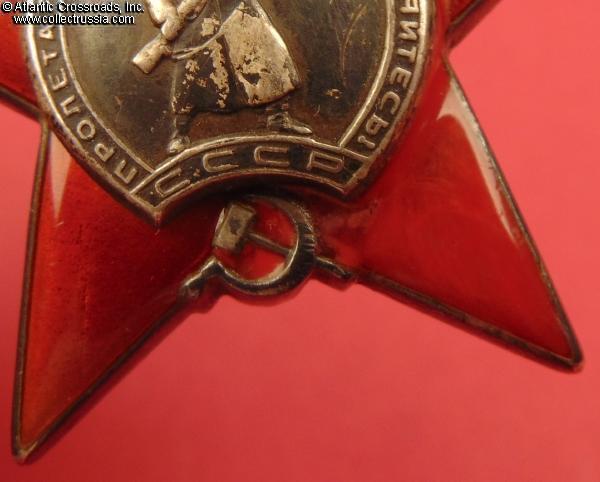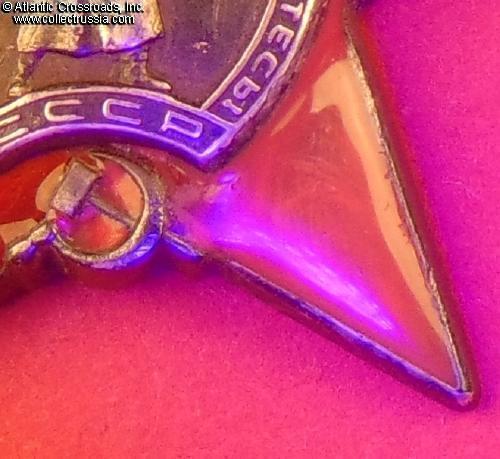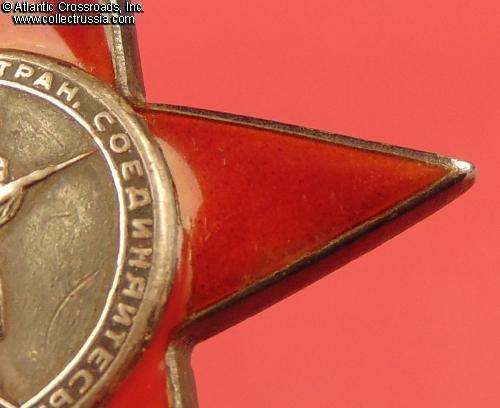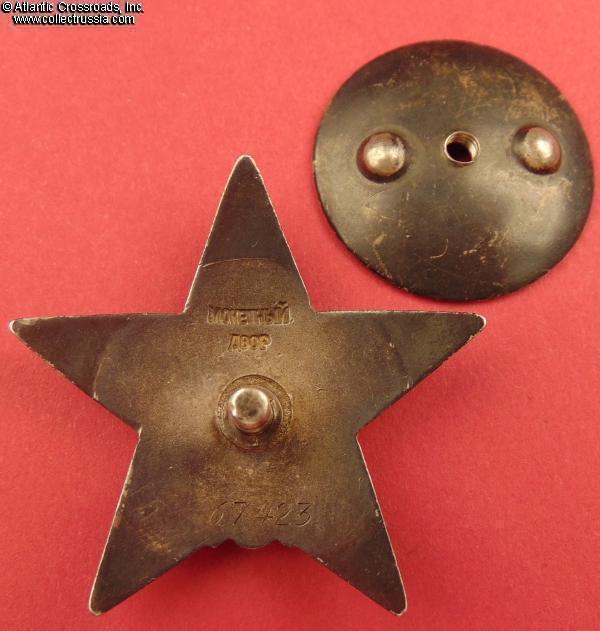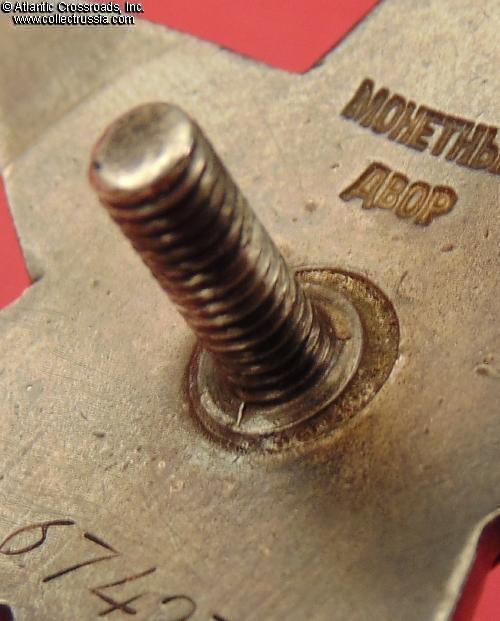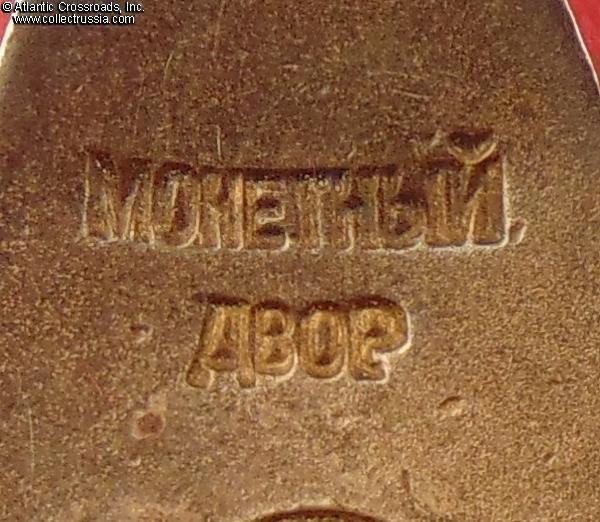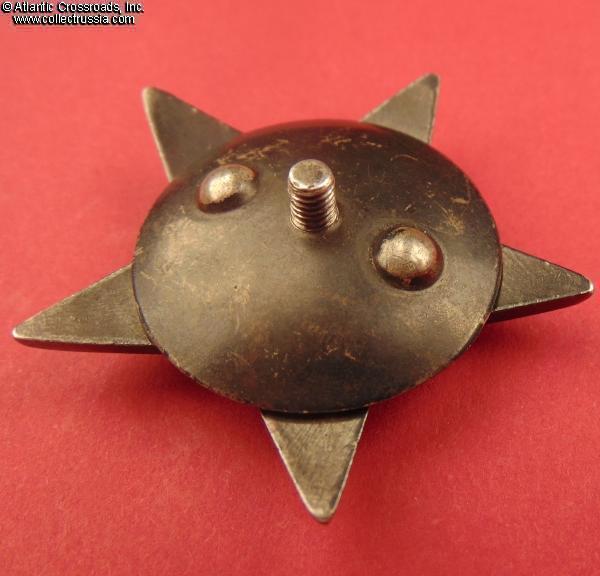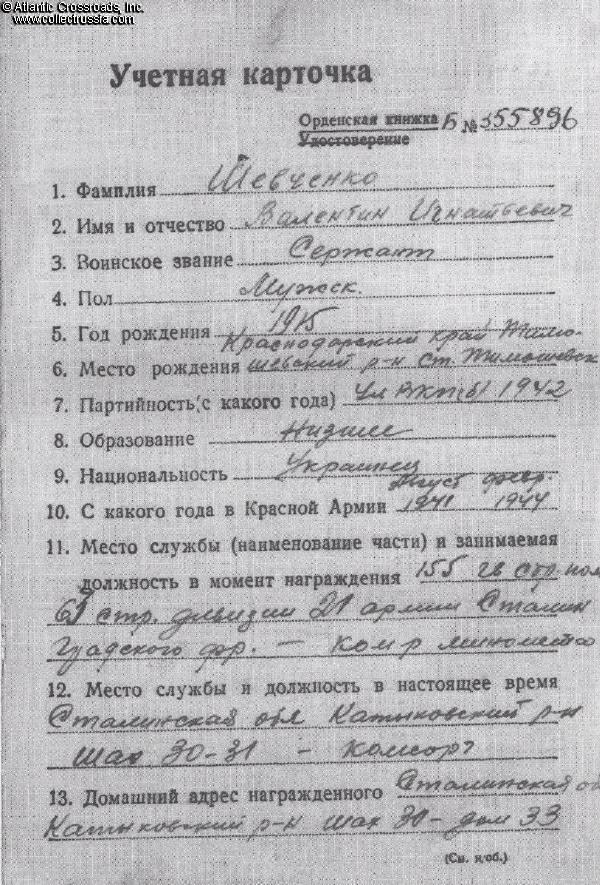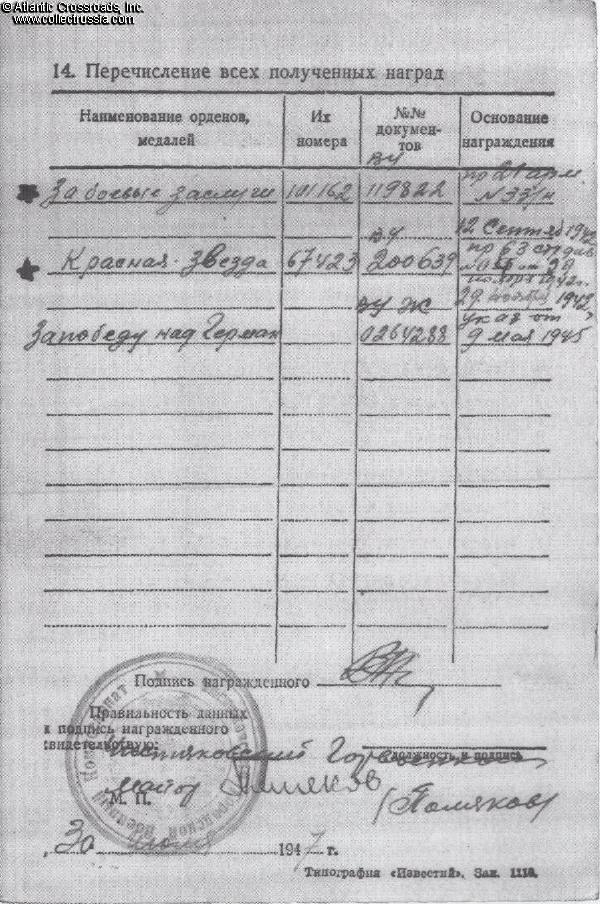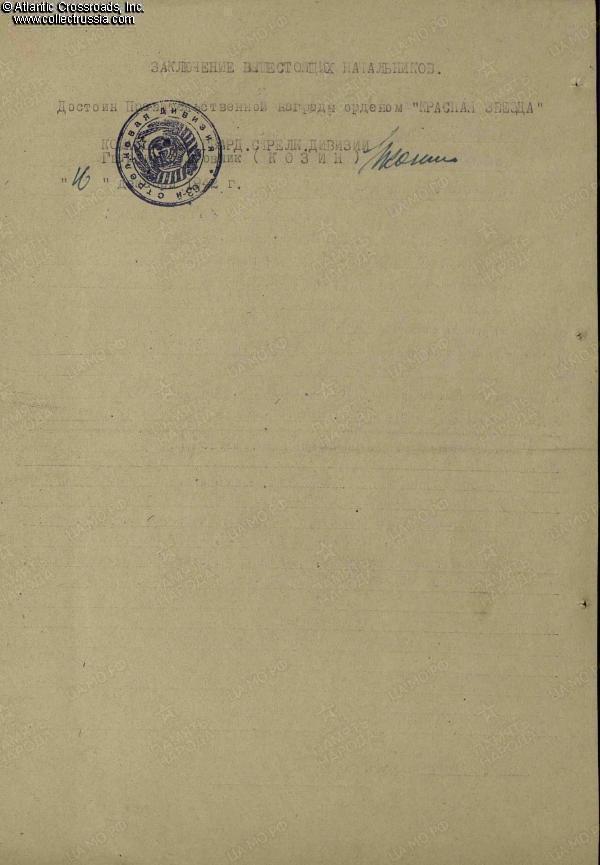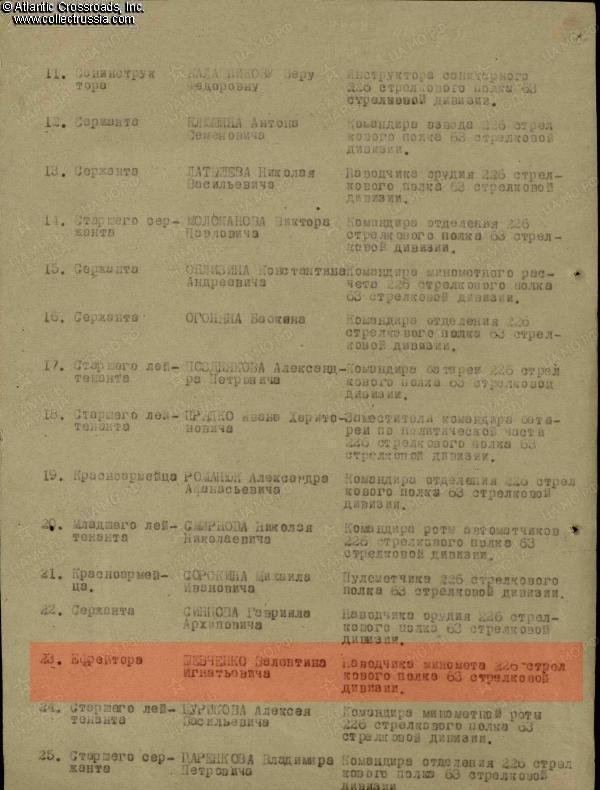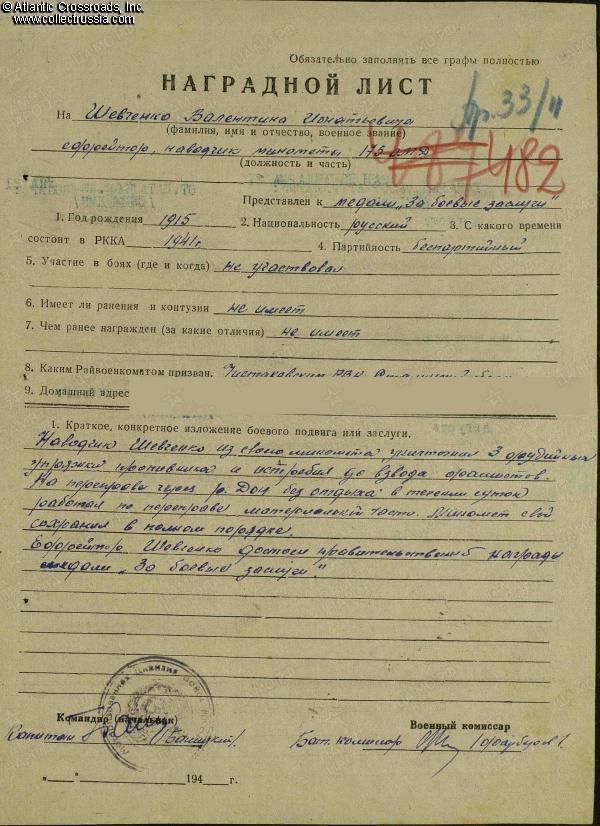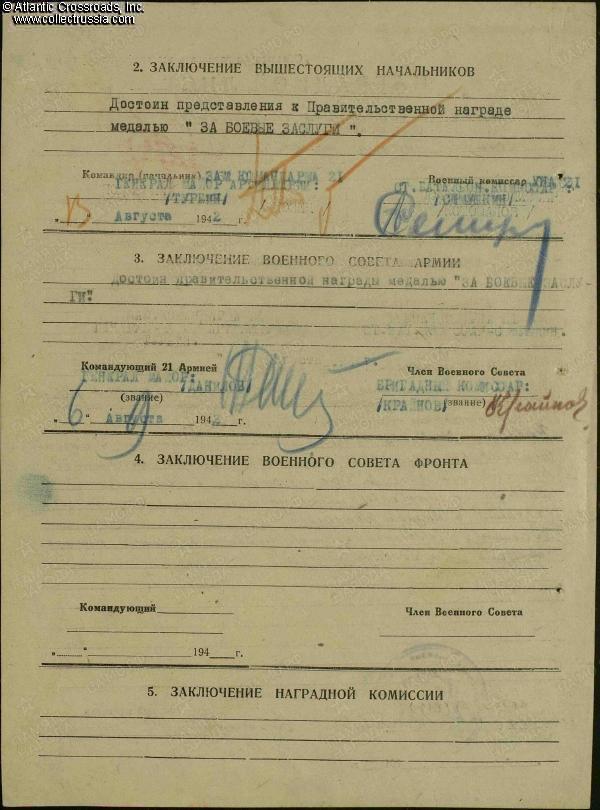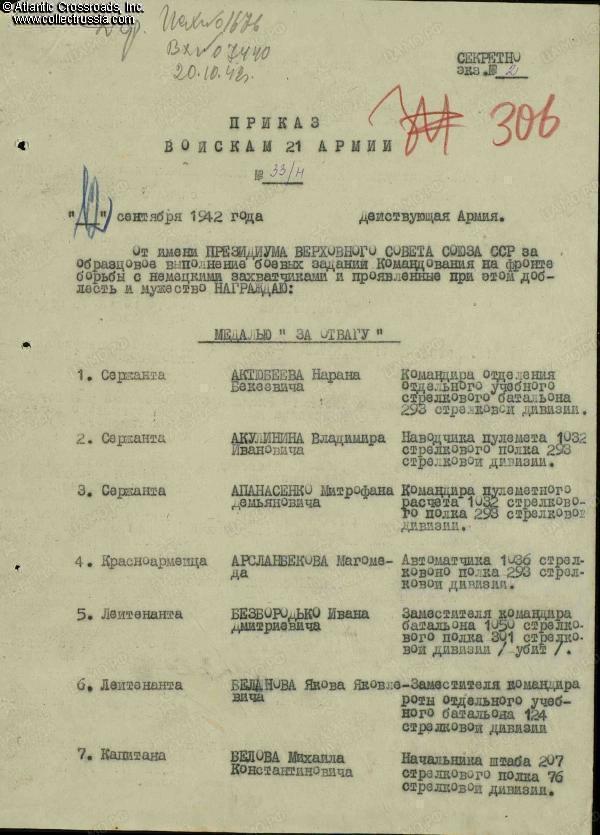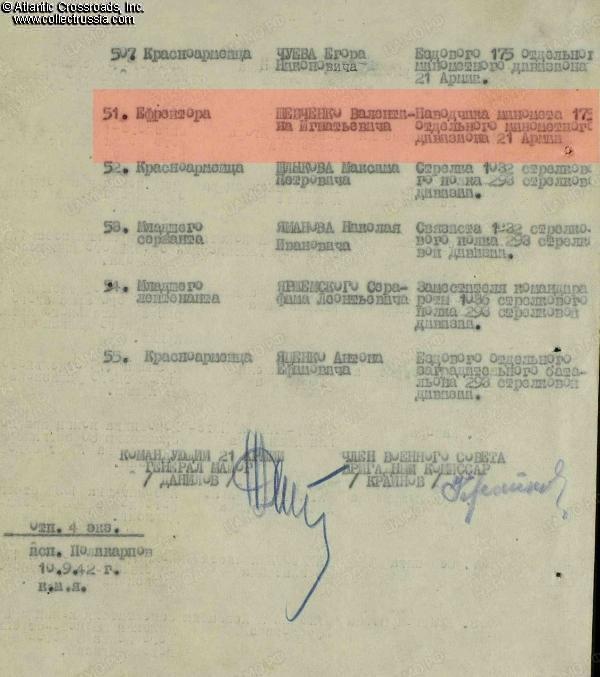|
https://collectrussia.com/DispitemWindowOrig.htm?item=42323 |
Order of the Red Star, Type 4 Variation 3, #67423, awarded on 29 November 1942 to Corporal Valentin Shevchenko (Валентин Игнатьевич Шевченко), 120-mm Mortar Crew Commander, 52nd Guards Rifle Division (formerly 63rd Rifle Division), 21st Army, Stalingrad Front, for outstanding contribution to the advance of his unit in the first days of the Soviet counteroffensive at Stalingrad (Operation Uran ).
Silver, enamels; measures 45.9 mm in height, 47.8 mm wide; weighs 31.5 g without the screw plate. This specimen was made in 1942 by the Moscow Mint, one of the early Red Stars made in the Soviet capital soon after their production was transferred there from the besieged Leningrad. Features a "sunk-in" screw post base and a slightly curved up mint mark with a dash in the last letter in the word "Monetnyi" located above the letter. The enamel is of characteristically fine quality and lighter shade compared with the later issues. /N. Strekalov, V. Durov, Order of the Red Star , pp. 230, 231/.
In fine condition. The enamel on the lower right arm is replaced with epoxy-based compound nicely matching the color of the original enamel and making the repair hard to notice under the normal light (it is however clearly visible under the UV light as shown in one of our photos.) There is also a surface chip along the lower edge of the upper right arm, not penetrating to the silver and therefore not too glaring. The enamel elsewhere has only some tiny contact marks and retains nice luster.
The raised points of the center medallion show mild wear, while the details of the artwork remain relatively well-preserved. There is a very attractive dark patina to silver on both sides. The screw post has not been shortened, measuring just under 12 mm in length, and includes an original period screw plate in silver. Overall, an attractive early piece.
Born in 1915 in a Kuban Cossack village of the Krasnodar (formerly Yekaterinodar) Territory of the Russian Empire to an ethnic Ukrainian family, Valentin Shevchenko joined the Red Army in August 1942, soon after the beginning of the Patriotic War. Instantly promoted to corporal - apparently due to showing leadership qualities from the start - he was appointed as a 120-mm mortar layer to the 175th Separate Mortar Squadron, 8th NKVD Motorized Rifle Division, 21st Army, Stalingrad Front. At the time, the Battle of Stalingrad was already in full swing, and the 21st Army held a defensive line along the Don River from Kletskaya to Serfafimovich just northwest of Stalingrad.
During the dire initial period of the battle, Shevchenko and his crew killed up to a platoon of enemy soldiers and destroyed 3 horse-drawn artillery pieces. In the first days of August, the 21st Army was pushed back across the Don River. During the retreat, Shevchenko worked on the river crossing for 24 hours straight without a break, making sure that all of the equipment and in particular his mortar was safely carried to the east bank - a significant consideration at the time when the Red Army was often critically short on weapons. Shevchenko was soon recommended for the Medal for Combat Service by his squadron commander. On 13 August, the recommendation was approved by the Deputy Commander of the 21st Army and on 6 September, received the final approval by the 21st Army Commander and Chief Political Officer. The award was officially bestowed on 12 September 1942 - one of the earliest awards of any kind for the Battle of Stalingrad. Soon afterwards, Shevchenko was promoted to command a mortar crew, while his NKVD Motorized Rifle division was transformed into the 63rd Rifle Division, still under the 21st Army.
In late August, the 21st Army counterattacked and along with the 63rd Army and General Pliev's cavalry group, regained a small bridgehead on the Don near Serafimovich that would play a key role in the Soviet counteroffensive in November. In the late-night hours of 18 November, the troops of the 21st Army (by then under the renamed Southwestern Front) were among the main forces of the Soviet northern pincer that struck from the Serafimovich bridgehead. Thus, they set in motion a chain of events destined to change the course of the war. The Soviet troops exploited harsh winter weather conditions and weakness of the German flanks. Within hours from the start of the operation codenamed Uran ("Uranus"), the 21st Army tore open the front of the Romanian 3rd Army. By doing so, it cleared the path for the armor of the Soviet 5th Tank Army to roll south towards Kletskaya and ultimately, Kalach-on-Don. The northern and southern Soviet pincers would meet near Kalach within a few days, trapping the Paulus' VI Army in Stalingrad.
Corp. Shevchenko greatly distinguished himself in the first days of the counter-offensive. From 19-24 November, he and his mortar crew provided excellent support to their regiment's advance near the stanitsa (Cossack village) of Raspopinskaya, about half-way between Serafimovich and Kletskaya. During this period, the crew eliminated 80 enemy soldiers. It also destroyed 2 heavy machine guns and silenced 3 light machine guns and a mortar battery.
On 13 December 1942, the regiment commander submitted a recommendation to award Shevchenko with the Order of the Red Star - among the earliest Soviet award commendations we have seen for the offensive part of the Battle of Stalingrad. What's even more interesting, the award had already been bestowed by that time! The official date of the 63rd Rifle Division's award decree that lists Shevchenko among the award recipients dates back to 29 November 1943, mere 11 days from the start of Operation Uran. This is apparently one of the rare cases when the award was issued "in the field" before the formalities could be attended to by the proper chain of command. (A similar case of such impromptu awards is described in the Russian war novel The Hot Snow by Yuri Bondarev and a popular Soviet movie by the same title based on the novel. In its poignant final scene, a general is handing over Orders of the Red Banners - saying, "all I can do for you, lads" - in a frozen field covered with dead bodies and burned-down German tanks to the few shell-shocked survivors; their unit had just sacrificed itself in stopping the Manstein's panzers that had attempted to relieve the Germans in Stalingrad.)
For its outstanding performance in the Soviet counteroffensive in the Battle of Stalingrad, the 63rd Rifle Division was soon promoted to Guards status, becoming the 52nd Guards Rifle Division. Shevchenko remained with this unit through February 1944, at which point he was honorably discharged from the military, almost without a doubt due to a severe combat injury or illness. As of July 1947, he worked as a Communist Youth organizer at one of the coal mines in the Stalino (now Donetsk) Region of Ukraine. The Medal for Combat Service and Order of the Red Star earned at Stalingrad remained his only decorations of WW2.
Research Materials: photocopy of the award record card as well as award commendations and relevant pages of the award decrees for the Medal for Combat Service and Order of the Red Star.
Item# 42323
$645.00 Add to cart

